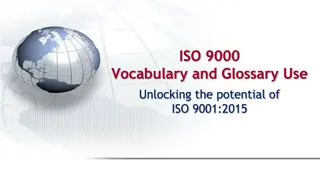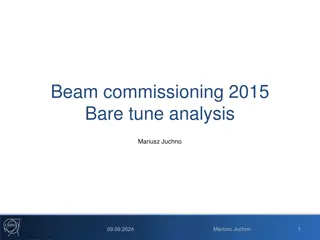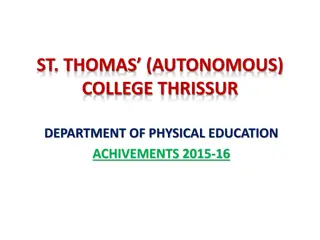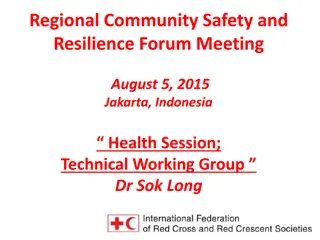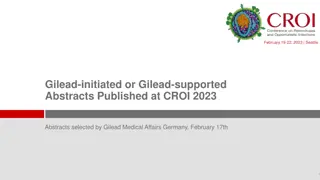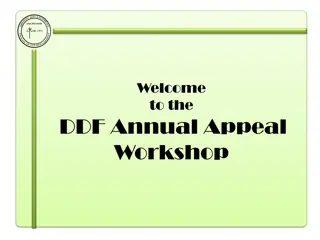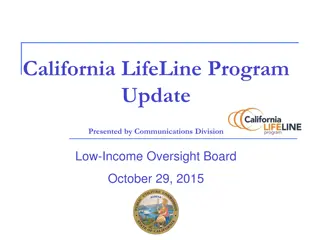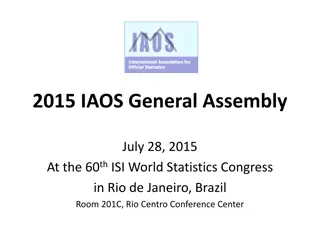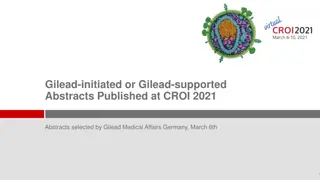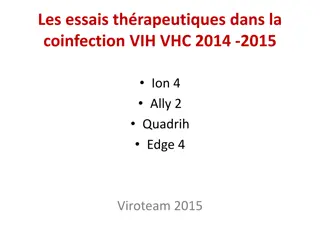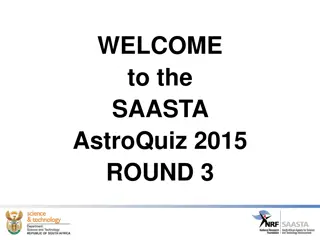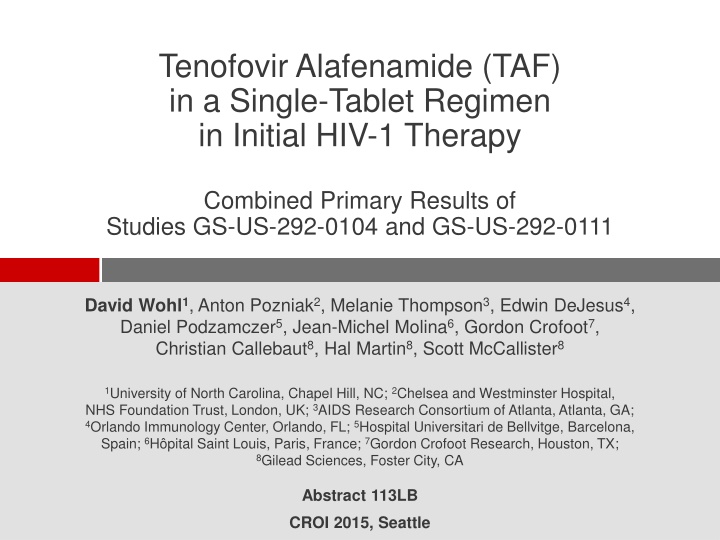
Combined Primary Results of Tenofovir Alafenamide (TAF) in HIV-1 Therapy Studies
Explore the combined primary results of studies GS-US-292-0104 and GS-US-292-0111 on the use of Tenofovir Alafenamide (TAF) in a single-tablet regimen for initial HIV-1 therapy. Learn about the efficacy and safety of this treatment option in treatment-naive adults. Presented by leading experts in the field at CROI 2015 in Seattle.
Download Presentation

Please find below an Image/Link to download the presentation.
The content on the website is provided AS IS for your information and personal use only. It may not be sold, licensed, or shared on other websites without obtaining consent from the author. If you encounter any issues during the download, it is possible that the publisher has removed the file from their server.
You are allowed to download the files provided on this website for personal or commercial use, subject to the condition that they are used lawfully. All files are the property of their respective owners.
The content on the website is provided AS IS for your information and personal use only. It may not be sold, licensed, or shared on other websites without obtaining consent from the author.
E N D
Presentation Transcript
Tenofovir Alafenamide (TAF) in a Single-Tablet Regimen in Initial HIV-1 Therapy Combined Primary Results of Studies GS-US-292-0104 and GS-US-292-0111 David Wohl1, Anton Pozniak2, Melanie Thompson3, Edwin DeJesus4, Daniel Podzamczer5, Jean-Michel Molina6, Gordon Crofoot7, Christian Callebaut8, Hal Martin8, Scott McCallister8 1University of North Carolina, Chapel Hill, NC; 2Chelsea and Westminster Hospital, NHS Foundation Trust, London, UK; 3AIDS Research Consortium of Atlanta, Atlanta, GA; 4Orlando Immunology Center, Orlando, FL; 5Hospital Universitari de Bellvitge, Barcelona, Spain; 6H pital Saint Louis, Paris, France; 7Gordon Crofoot Research, Houston, TX; 8Gilead Sciences, Foster City, CA Abstract 113LB CROI 2015, Seattle
Author Disclosures Dr. Wohl has served as an advisor to Gilead Sciences and Janssen, and the University of North Carolina Chapel Hill has received funding from Gilead Sciences and Merck 2
Background Tenofovir disoproxil fumarate (TDF) is included in most recommended antiretroviral regimens, and although potent and generally well tolerated, has been associated with clinically significant renal and bone toxicity1-3 Relative to TDF 300 mg, tenofovir alafenamide (TAF) 25 mg has 90% lower circulating plasma TFV, while maintaining high antiviral activity4 In Phase 2, efficacy of elvitegravir, cobicistat, emtricitabine, and TAF (E/C/F/TAF) was comparable to E/C/F/TDF, and demonstrated significant improvements in renal and bone safety5 We sought to confirm the efficacy of E/C/F/TAF in two fully powered clinical trials 1. DeJesus E, et al. Lancet 2012;379:2429-38; 2. Gallant JE, et al. J Infect Dis 2013;208:32-9; 3. Sax PE, et al. Lancet 2012;379:2439-48; 4. Ruane P, et al. J Acquir Immune Defic Syndr 2013; 63:449-55; 5. Sax PE, et al. J Acquir Immune Defic Syndr 2014;67:52-8. 3
Study Design: Studies 104 and 111 Primary Endpoint 48 Week 0 96 144 n=866 E/C/F/TAF QD Tx-Na ve Adults HIV-1 RNA 1000 c/mL eGFR 50 mL/min 1:1 E/C/F/TDF QD (Stribild, STB) n=867 Two Phase 3 randomized, double-blind, double-dummy, active-controlled studies Study 104 (North America, EU, Asia), Study 111 (North America, EU, Latin America) Stratified by HIV-1 RNA, CD4 cell count, geographic region Primary endpoint: proportion of patients with HIV-1 RNA <50 copies/mL (Taqman 2.0) Non-inferiority (12% margin) based on Week 48 FDA snapshot analysis Combined efficacy analysis pre-specified Pre-specified Week 48 safety endpoints: serum creatinine, proteinuria, hip BMD, spine BMD 4
Baseline Characteristics Studies 104 and 111: Week 48 Combined Analysis E/C/F/TAF n=866 E/C/F/TDF n=867 Median age, years 33 35 Sex, % Male 85 85 Female 15 15 Race/ethnicity, % Black or African descent 26 25 Hispanic/Latino ethnicity 19 19 Median HIV-1 RNA, log10 c/mL % with HIV-1 RNA >100,000 c/mL 4.58 4.58 23 23 Median CD4 count, cells/ L 404 406 % with CD4 count <200 13 14 Median estimated GFR*, mL/min 117 114 *Cockcroft-Gault. 5
Patient Disposition Studies 104 and 111: Week 48 Combined Analysis Screened (N=2,175) Randomized, treated with E/C/F/TAF n=866 Randomized, treated with E/C/F/TDF n=867 8% Discontinued (n=71) Adverse event (13) Death (2) Lack of efficacy (3) Withdrew consent (16) Lost to follow-up (18) Subject non-compliance (1) Protocol violation (6) Investigator discretion (7) Pregnancy (5) 5% Discontinued (n=45) Adverse event (8) Death (1) Lack of efficacy (2) Withdrew consent (12) Lost to follow-up (15) Subject non-compliance (2) Protocol violation (5) 95% on Treatment n=821 92% on Treatment n=796 6
Primary Endpoint: HIV-1 RNA <50 copies/mL at Week 48 Studies 104 and 111: Week 48 Combined Analysis Treatment Difference (95% CI) Virologic Outcome E/C/F/TAF (n=866) E/C/F/TDF (n=867) HIV-1 RNA <50 c/mL, % 100 92 Favors E/C/F/TDF Favors E/C/F/TAF 90 80 60 2.0% 0.7% 4.7% 40 20 6 4 4 4 0 +12% 0 12% Success Failure No Data E/C/F/TAF was non-inferior to E/C/F/TDF at Week 48 in each study 93% E/C/F/TAF vs 92% E/C/F/TDF (Study 104) 92% E/C/F/TAF vs 89% E/C/F/TDF (Study 111) 7
Efficacy by Baseline HIV-1 RNA and CD4 Count Studies 104 and 111: Week 48 Combined Analysis E/C/F/TAF (n=866) E/C/F/TDF (n=867) Viral Load Cell Count Overall 100 94 93 92 91 91 90 89 89 87 86 Virologic Success (%) 80 60 40 20 800 866 784 867 629 670 610 672 171 196 174 195 96 112 104 117 703 753 680 750 0 >100,000 <200 200 100,000 HIV-1 RNA (c/mL) CD4 (cells/ L) 8
Efficacy in Select Subgroups Studies 104 and 111: Week 48 Combined Analysis E/C/F/TAF (n=866) E/C/F/TDF (n=867) Age Sex Race Overall 100 95 94 94 93 92 92 92 91 91 90 90 88 87 83 Virologic Success (%) 80 60 40 20 800 866 784 867 716 777 680 753 84 89 104 114 674 733 673 740 126 133 111 127 603 643 607 654 197 223 177 213 0 <50 years 50 years Male Female Non-Black Black 9
Median Change from Baseline in CD4 Count Studies 104 and 111: Week 48 Combined Analysis E/C/F/TDF E/C/F/TAF 300 Median Change from Baseline in CD4 Count (cells/ L) 211 200 p=0.024 181 100 0 0 4 8 12 16 20 24 28 32 36 40 44 48 52 2 Weeks 10
Resistance Through Week 48 Studies 104 and 111: Week 48 Combined Analysis E/C/F/TAF n=866 16 (1.8) 7 (0.8) 3 4 7 6 1 5 1 2 0 1 0 1 E/C/F/TDF n=867 19 (2.2) 5 (0.6) 3 2 5 3 2 3 0 1 1 0 1 0 Patients analyzed for resistance*, n (%) Any, n (%) Study 104, n Study 111, n Any M184V/I M184V/I + K65R Any T66A E92Q Q148R Q148R + T66I/A Q148R + E92Q N155H Primary Genotypic Resistance NRTI Resistance, n INSTI Resistance, n *With 2 consecutive HIV-1 RNA 50 c/mL after first achieving <50 c/mL and the second 400 c/mL; or had 400 c/mL at Week 48 or last study visit. 11
Overall Safety Studies 104 and 111: Week 48 Combined Analysis E/C/F/TAF n=866 % E/C/F/TDF n=867 % Any AE 90 90 Any drug-related AE 40 42 Any Grade 3 or 4 AE 8 9 Any drug-related Grade 3 or 4 AE 1 1 Any serious AE 8 7 Any drug-related serious AE 0.3 0.2 Any AE-related discontinuation 0.9 1.5 Deaths 0.2* 0.3 *Stroke (1), alcohol intoxication (1). Alcohol and drug intoxication (1), myocardial infarction (2). 12
Adverse Events Leading to Discontinuation Studies 104 and 111: Week 48 Combined Analysis E/C/F/TAF n=866 E/C/F/TDF n=867 % (n) 0.9% (8) 1.5% (13) Blood triglycerides increased Cerebral infarction, hemorrhagic transformation stroke Dyspnea, hyperkeratosis, abdominal distention & pain, back pain, lipodystrophy acquired Dysphagia, pharyngitis Erectile dysfunction Eye irritation, eye pain, eye pruritus Proctalgia, penile pain Rash erythematous Arthropod bite, dermatitis Abdominal pain, temporomandibular joint syndrome, headache, depression Cardiac arrest Dysphagia, nausea, vomiting Decreased GFR Hyperamylasemia Immune reconstitution inflammatory syndrome Iridocyclitis Nephropathy Rash generalized Renal failure (2) Vomiting, bladder spasm, pyrexia, headache, myalgia, rash maculopapular Type 13 13
Common Adverse Events (All Grades) Studies 104 and 111: Week 48 Combined Analysis E/C/F/TAF n=866 17 15 14 11 9 8 8 7 7 7 7 6 5 5 E/C/F/TDF n=867 19 17 13 13 9 8 7 6 5 7 6 5 5 4 AEs in 5% of patients, % Diarrhea Nausea Headache Upper respiratory tract infection Nasopharyngitis Fatigue Cough Vomiting Arthralgia Back pain Insomnia Rash Pyrexia Dizziness 14
Grade 3 or 4 Laboratory Abnormalities Studies 104 and 111: Week 48 Combined Analysis E/C/F/TAF n=866 % 20 7 5 2 2 2 2 2 1 E/C/F/TDF n=867 % 20 6 2 1 2 2 3 2 1 Any grade 3 or 4 lab abnormalities* Creatine kinase elevation LDL elevation (fasting) Hypercholesterolemia (fasting) Hematuria (quantitative) AST elevation Serum amylase elevation Neutropenia (<1000 cells/ L) ALT elevation * 1% on E/C/F/TAF arm. 15
Conclusions Studies 104 and 111: Week 48 Combined Analysis 92% of patients treated with E/C/F/TAF achieved virologic suppression through Week 48 (combined analysis) Virologic response for E/C/F/TAF, 93% (Study 104) and 92% (Study 111) E/C/F/TAF was non-inferior to E/C/F/TDF High and similar response rates, irrespective of age, sex, race, HIV-1 RNA, and CD4 cell count Low rates of virologic failure, with resistance <1% in both arms Both drugs were well tolerated and safe Discontinuations due to AEs were low in both arms 0.9% (8) for E/C/F/TAF vs 1.5% (13) for E/C/F/TDF No proximal tubulopathy cases Common AEs similar between treatment arms 16
Additional Data Detailed resistance analysis (Margot, Poster #6) HIV Drug Resistance Workshop (Feb 21-22) Off-target side effects of tenofovir (renal, bone, lipid) (Sax, #143LB) Feb 26th Oral Abstract Session: Cardiovascular, Bone, and Kidney Health Patients with mild to moderate renal impairment (eGFR 30-69 mL/min) who switch to E/C/F/TAF, bone mineral density and markers of kidney function improved through 48 weeks (Pozniak, Poster #795) Complete results of Studies 104 and 111 submitted for peer-reviewed publication Health authority filings submitted and under review in multiple countries 17
Acknowledgments We extend our thanks to the patients, their partners and families, and all participating Study 104 & 111 investigators C Achenbach, F Ajana, B Akil, H Albrecht, J Andrade Villanueva, J Angel, A Antela Lopez, J Arribas Lopez, A Avihingsanon, D Baker, J-G Baril, D Bell, N Bellos, P Benson, J Berenguer, I Bica, A Blaxhult, M Bloch, P Brachman, I Brar, K Brinkman, C Brinson, B Brown, J Brunetta, J Burack, T Campbell, M Cavassini, A Cheret, P Chetchotisakd, A Clarke, B Clotet, N Clumeck, C Cohen, P Cook, L Cotte, D Coulston, M Crespo, C Creticos, G Crofoot, F Cruickshank, J Cunha, E Daar, E DeJesus, J De Wet, M Doroana, R Dretler, M Dube, J Durant, H Edelstein, R Elion, J Fehr, R Finlayson, D Fish, J Flamm, S Follansbee, H Furrer, F Garcia, J Gatell Artigas, J Gathe, S Gilroy, P-M Girard, J-C Goffard, E Gordon, P Grant, R Grossberg, C Hare, T Hawkins, R Hengel, K Henry, A Hite, G Huhn, M Johnson, M Johnson, K Kasper, C Katlama, S Kiertiburanakul, JM Kilby, C Kinder, D Klein, H Knobel, E Koenig, M Kozal, R Landovitz, J Larioza, A Lazzarin, R LeBlanc, B LeBouche, S Lewis, S Little, C Lucasti, C Martorell, C Mayer, C McDonald, J McGowan, M McKellar, G McLeod, A Mills, J-M Molina, G Moyle, M Mullen, C Mussini, R Nahass, C Newman, S Oka, H Olivet, C Orkin, P Ortolani, O Osiyemi, F Palella, P Palmieri, D Parks, A Petroll, G Pialoux, G Pierone, D Podzamczer Palter, C Polk, R Pollard, F Post, A Pozniak, D Prelutsky, A Rachlis, M Ramgopal, B Rashbaum, W Ratanasuwan, R Redfield, G Reyes Teran, J Reynes, G Richmond, A Rieger, B Rijnders, W Robbins, A Roberts, J Ross, P Ruane, R Rubio Garcia, M Saag, J Santana- Bagur, L Santiago, R Sarmento e Castro, P Sax, B Schmied, T Schmidt, S Schrader, A Scribner, S Segal- Maurer, B Sha, P Shalit, D Shamblaw, C Shikuma, K Siripassorn, J Slim, L Sloan, D Smith, K Squires, D Stein, J Stephens, K Supparatpinyo, K Tashima, S Taylor, P Tebas, E Teofilo, A Thalme, M Thompson, W Towner, T Treadwell, B Trottier, T Vanig, N Vetter, P Viale, G Voskuhl, B Wade, S Walmsley, D Ward, L Waters, D Wheeler, A Wilkin, T Wilkin, E Wilkins, T Wills, D Wohl, M Wohlfeiler, K Workowski, B Yangco, Y Yazdanpanah, G-P Yeni, M Yin, B Young, A Zolopa, C Zurawski This study was funded by Gilead Sciences, Inc. 18

